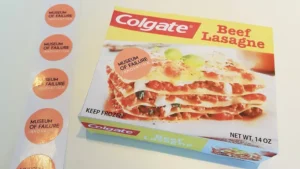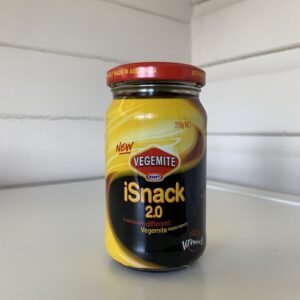As a marketer, dedicated to learning and improving, the bookcase at home is full of books on marketing, advertising, branding, and design. Many of them are massive, weighty texts, filled with the thoughts of the most iconic minds in marketing.
But I have an admission to make. The books that are the most dog-eared, the most thumbed-through, the most worn, are those about marketing failures. Big ones.
I am like a moth to a flame when that flame is a story about epic brand and product failures.

There’s so many stories – cautionary tales – that it’s hard to know where to start.
Sure, most people born before the turn of the millennium would have heard about ‘New Coke’, but that’s too mainstream for me. And besides, changing the recipe in your product is not exactly revolutionary. In the case of New Coke, it’s just that they got it wrong. On a massive scale. Similarly, Pepsi’s clear cola (Crystal) or their ‘breakfast soda’ – Pepsi AM – all blew up spectacularly, but that came down to chasing customer segments that simply didn’t exist.
Some will be captivated by the re-branding of PWC’s consulting division to ‘Monday’ (which was scrapped in very short order, but not after burning through millions in contriving, executing, and announcing it.)
And closer to home, iSnack 2.0, from Vegemite, surely deserves some attention.

Brand extension hall of shame
But no. The failures I find the most interesting – the ones that truly are deserving of the ‘What were they thinking?’ awards – are the ones around brand extensions – where a brand that is incredibly successful in one category decides to take that brand equity and completely trash it in another, usually unrelated, category.
In Australia, the ‘Tradie’ brand could well end up as one such case study. Starting a decade or so ago selling basic underwear, using Nick ‘The Honey Badger’ Cummins in its advertising, the Tradie brand has been extended into categories for the entire family including workwear, boots, baby wear, tools, drinks, food, and beauty.
Most recently, I have seen them flogging Tradie beer. I get the logic. Tradie’s drink beer. They’ve even covered all their bases with the three popular beer categories – your flavoursome IPA, your bog-standard lager, and your low carb beer for the younger, more ‘health/appearance’ conscious sparky and chippy.
But would they rather slam down a ‘tradie’ than an ice-cold VB or Tooheys Super Dry? Even in these ‘cost of living crisis’ times, I am not sure.

Time will tell if I need to stand corrected on that one.
But while the fate of tradie beer may be too early to determine, history is still littered with some absolute solid gold doozies of marketing and branding failures. Think:
- Bic perfume, or
- Gerber Baby food for adults, or
- Cosmopolitan (the magazine) yoghurt, or
- Lifesavers soft drink, or
- Colgate lasagne.
Lack of alignment
The common element shared by all these examples is the lack of alignment – between what a brand stood for – and could credibly stand for in the eyes of the target audience – and what it was trying to stand for with these new products.
Consumers just couldn’t come at the idea of a brand famous for pens and cigarette lighters (Bic) doing perfume. Nor an oral hygiene brand doing microwave meals. Nor a fashion and lifestyle magazine doing yoghurt. I mean, come on. The alignment between brand credibility and capability and consumer expectations is zero.
The dimensions of alignment
There are several dimensions of alignment that are critical drivers of marketing effectiveness:
- Ensuring your messaging is aligned/consistent across all channels/media
- Ensuring your messaging is aligned with the needs and behaviours of the target avatar
- Ensuring that your proposition – what you can actually deliver as a brand – aligns with what your messaging says you can do.
It seems common sense to say that increasing the alignment increases the effectiveness of your marketing, and it is. Greater consistency increases the cut through and retention of your messaging – amplifying its power by being single minded. Frequency and Reach are the Batman and Robin – the dynamic duo – of advertising, and aligning your messages across your existing activity is an easy way to boost your frequency at no extra cost.
Aligning your messaging across different brand touchpoints is also critical. In the digital age, even the smallest businesses need an omnichannel approach, and inconsistent messaging and experiences between channels can erode brand trust. It’s likely no surprise, but according to an article I read in Forbes magazine, a consistent brand experience across channels can increase revenue by 23%.
Your messaging must align with your target markets, as well as the personas – we call them avatars – within these market segments. This means understanding what they need, what they want, and what drives their decisions. Understanding these aspects can take time, research, and lots and lots of data
Proposition alignment – turning up to a black-tie event in jeans and a tee
Misalignment between proposition and messaging – in other words, not being able to do what you say you can – is damaging if you get it wrong. Targeting a younger audience with an old school service proposition (and a poor digital experience) is a recipe for disaster. Similarly, brands targeting high net worth clients but not backing it with the right product and service proposition won’t get far. Nor will positioning yourself as a champion of innovation but still needing wet signatures on documents.
Message alignment can be hard when there are multiple authors
In a category as content heavy as financial services, the opportunities for misaligned messaging are amplified. Think research reports, digital advertising, brochures and PDSs, websites, presentations, videos, social posts, emails, and media releases. So many messages, trying to do so many jobs, across so many channels, to so many people. And all produced by different parts of the business, from product managers to marketers to PR teams to researchers. All with their own styles and priorities. No wonder it’s so easy for misalignment to creep in!
At Ensombl, alignment is what we do
There are now around 8,500 members of the Ensombl community, and at the heart of that community sits our Q&A platform. This is where advisors come to learn, share, and collaborate, and whether they are posing or answering a question, liking, commenting on, or even just viewing content, they are providing us the richest of insights into what content and channels they engage with, and what problems they are looking to solve. In the broadest of terms, they are telling us what they want.
This wealth of behavioural data allows us to build incredibly rich advisor avatars, beyond the superficial (practice size, FUM amount, CRM used) and into deep, meaningful pictures of who they are, how they want to engage, and what they need help with.
That means when we work with corporate partners, we are in a perfect position to serve the most effective content through the most effective channels. And because that content is insight led it is – by definition – aligned with the needs of the audience, and as result tends to be highly effective.
As an innovative organisation, it shouldn’t surprise you to learn we’ve been aboard the AI train for a while, and we’ve got a team of Natural Language Processing (NLP) experts working on this data, bringing the deepest of insights to the surface, paving the way for us to help brands define, measure, and achieve their own brand alignment.
If marketing ROI is something you care about, or to make sure you don’t serve toothpaste buyers with lasagna, get in touch, we’d love to explain more.

